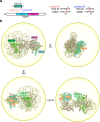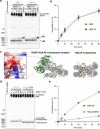Molecular and structural basis of the chromatin remodeling activity by Arabidopsis DDM1
- PMID: 38992002
- PMCID: PMC11239853
- DOI: 10.1038/s41467-024-49465-w
Molecular and structural basis of the chromatin remodeling activity by Arabidopsis DDM1
Abstract
The histone H2A variant H2A.W occupies transposons and thus prevents access to them in Arabidopsis thaliana. H2A.W is deposited by the chromatin remodeler DDM1, which also promotes the accessibility of chromatin writers to heterochromatin by an unknown mechanism. To shed light on this question, we solve the cryo-EM structures of nucleosomes containing H2A and H2A.W, and the DDM1-H2A.W nucleosome complex. These structures show that the DNA end flexibility of the H2A nucleosome is higher than that of the H2A.W nucleosome. In the DDM1-H2A.W nucleosome complex, DDM1 binds to the N-terminal tail of H4 and the nucleosomal DNA and increases the DNA end flexibility of H2A.W nucleosomes. Based on these biochemical and structural results, we propose that DDM1 counters the low accessibility caused by nucleosomes containing H2A.W to enable the maintenance of repressive epigenetic marks on transposons and prevent their activity.
© 2024. The Author(s).
Conflict of interest statement
The authors declare no competing interests.
Figures








Similar articles
-
DDM1 Maintains Heterochromatin by Regulating Histone Variants.Int J Mol Sci. 2025 May 19;26(10):4845. doi: 10.3390/ijms26104845. Int J Mol Sci. 2025. PMID: 40429984 Free PMC article. Review.
-
Mechanism of heterochromatin remodeling revealed by the DDM1 bound nucleosome structures.Structure. 2024 Aug 8;32(8):1222-1230.e4. doi: 10.1016/j.str.2024.05.013. Epub 2024 Jun 12. Structure. 2024. PMID: 38870940
-
Molecular basis of chromatin remodelling by DDM1 involved in plant DNA methylation.Nat Plants. 2024 Mar;10(3):374-380. doi: 10.1038/s41477-024-01640-z. Epub 2024 Feb 27. Nat Plants. 2024. PMID: 38413824
-
The chromatin remodeler DDM1 prevents transposon mobility through deposition of histone variant H2A.W.Nat Cell Biol. 2021 Apr;23(4):391-400. doi: 10.1038/s41556-021-00658-1. Epub 2021 Apr 8. Nat Cell Biol. 2021. PMID: 33833428
-
To slide or not to slide: key role of the hexasome in chromatin remodeling revealed.Nat Struct Mol Biol. 2024 May;31(5):742-746. doi: 10.1038/s41594-024-01278-7. Epub 2024 May 20. Nat Struct Mol Biol. 2024. PMID: 38769465 Review.
Cited by
-
An Oryza-specific histone H4 variant predisposes H4 lysine 5 acetylation to modulate salt stress responses.Nat Plants. 2025 Apr;11(4):790-807. doi: 10.1038/s41477-025-01974-2. Epub 2025 Apr 8. Nat Plants. 2025. PMID: 40200022 Free PMC article.
-
Mind the gap: Epigenetic regulation of chromatin accessibility in plants.Plant Physiol. 2024 Mar 29;194(4):1998-2016. doi: 10.1093/plphys/kiae024. Plant Physiol. 2024. PMID: 38236303 Free PMC article. Review.
-
Mutation of ZmDIR5 Reduces Maize Tolerance to Waterlogging, Salinity, and Drought.Plants (Basel). 2025 Mar 4;14(5):785. doi: 10.3390/plants14050785. Plants (Basel). 2025. PMID: 40094739 Free PMC article.
-
DDM1 Maintains Heterochromatin by Regulating Histone Variants.Int J Mol Sci. 2025 May 19;26(10):4845. doi: 10.3390/ijms26104845. Int J Mol Sci. 2025. PMID: 40429984 Free PMC article. Review.
-
Reactivation of the tRNASer/tRNATyr gene cluster in Arabidopsis thaliana root tips.Plant Cell. 2025 Jul 1;37(7):koaf137. doi: 10.1093/plcell/koaf137. Plant Cell. 2025. PMID: 40479509 Free PMC article.
References
MeSH terms
Substances
Grants and funding
- JPMJPR20K3/MEXT | JST | Precursory Research for Embryonic Science and Technology (PRESTO)
- JP22H05178/MEXT | Japan Society for the Promotion of Science (JSPS)
- JP22H05172/MEXT | Japan Society for the Promotion of Science (JSPS)
- P 32054/FWF_/Austrian Science Fund FWF/Austria
- P 33380/FWF_/Austrian Science Fund FWF/Austria
LinkOut - more resources
Full Text Sources

